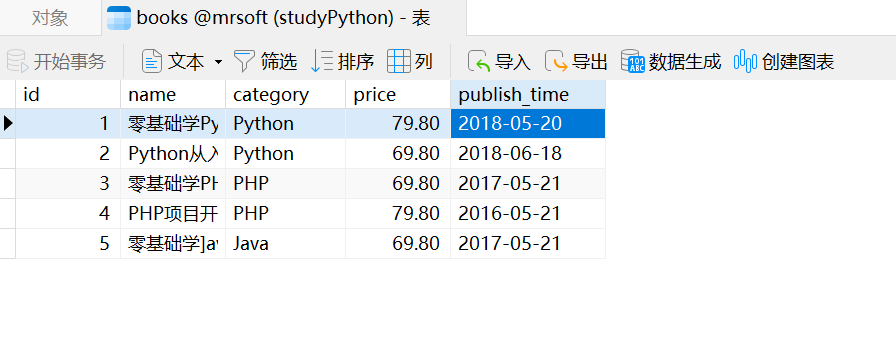实验11:使用Python操作数据库
一、实验目的和要求
1、学会数据库编程接口;
2、学会使用SQLite;
3、学会使用MySQL。
二、实验环境
软件版本:Python 3.10 64_bit
三、实验过程
1、实例1:创建SQLite数据库文件
创建一个mrsoft.db的数据库文件,然后执行SQL语句可创建一个 user(用户表),user表包含id和name两个字段,代码如下:
1 import sqlite3
2 # 连接到SQLite数据库
3 # 数据库文件是mrsoft.db,如果文件不存在,会自动在当前目录创建
4 conn = sqlite3.connect('mrsoft.db')
5 # 创建一个Cursor
6 cursor = conn.cursor()
7 # 执行一条SQL语句,创建user表
8 cursor.execute("create table user (id int(10) primary key, name varchar(29))")
9 # 关闭游标
10 cursor.close()
11 # 关闭Connection
12 conn.close()
2、实例2:新增用户数据信息
由于在实例1中已经创建了user表,所以本实例可以直接操作user表,向user表中插入3条用户信息。此外,由于是新增数据,需要使用commit()方法提交事务。因为对于增加、修改和删除操作,使用commit()方法提交事务后,如果相应操作失败,可以使用rollback()方法回滚到操作之前的状态。新增用户数据信息的代码如下:
1 import sqlite3
2 # 连接到sQlite数据库
3 # 数据库文件是mrsoft.db
4 # 如果文件不存在,会自动在当前目录创建
5 conn = sqlite3.connect('mrsoft.db')
6 # 创建一个Cursor
7 cursor = conn.cursor()
8 #执行一条SQL语句,插入一条记录
9 cursor.execute('insert into user (id, name) values ("1", "MRSOFT")')
10 cursor.execute('insert into user (id, name) values ("2","Andy")')
11 cursor.execute('insert into user (id, name) values ("3","明日科技小助手")')
12 # 关闭游标
13 cursor.close()
14 # 提交事务
15 conn.commit()
16 # 关闭Connection
17 conn.close()
3、实例3:使用3种方法查询用户数据信息
(1)分别使用fetchone、fetchmany和fetchall这3种方式查询用户信息,具体代码如下:
1 import sqlite3
2 # 连接到SQLite数据库,数据库文件是mrsoft.db
3 conn =sqlite3.connect("mrsoft.db")
4 # 创建一个Cursor
5 cursor =conn.cursor()
6 #执行查询语句
7 cursor.execute("select * from user where id > ?",(0,))
8 # 获取查询结果
9 result1 = cursor.fetchall()
10 print(result1)
11 # 关闭游标
12 cursor.close()
13 # 关闭Connection
14 conn.close()
(2)运行结果如图所示:
![]()
4、实例4:修改用户数据信息
(1)将SQLite数据库中user表ID为1的数据name字段值“mrsoft”修改为“MR”,并使用fetchAll获取表中的所有数据。具体代码如下:
1 import sqlite3
2 # 连接到sQLite数据库,数据库文件是mrsoft.db
3 conn = sqlite3.connect('mrsoft.db')
4 # 创建一个Cursor:
5 cursor =conn.cursor()
6 cursor.execute("update user set name = ? where id = ?",("MR",1))
7 cursor.execute("select * from user")
8 result = cursor.fetchall()
9 print(result)
10 # 关闭游标
11 cursor.close()
12 # 提交事务
13 conn.commit()
14 # 关闭Connection:
15 conn.close()
(2)运行结果如图所示:
![]()
5、实例5:删除用户数据信息
(1)将SQLite数据库中user表ID为1,2,3的数据删除,并使用fetchAll获取表中所有数据,查看删除后的结果。具体代码如下:
1 import sqlite3
2 # 连接到SQLite数据库,数据库文件是mrsoft.db
3 conn = sqlite3.connect("mrsoft.db")
4 # 创建一个Cursor:
5 cursor = conn.cursor()
6 cursor.execute("delete from user where id = ?",(1,))
7 cursor.execute("delete from user where id = ?",(2,))
8 cursor.execute("delete from user where id = ?",(3,))
9 cursor.execute("select * from user")
10 result = cursor.fetchall()
11 print(result)
12 # 关闭游标
13 cursor.close()
14 # 提交事务
15 conn.commit()
16 # 关闭Connection:
17 conn.close()
(2)运行结果如图所示:

6、实例6:使用PyMySQL连接数据库
(1)前面我们已经创建了一个MySQL连接“studyPython”,并且在安装数据库时设置了数据库的用户名“root”和密码“root”。下面通过connect()方法接MySQL数据库mrsoft,具体代码如下:
1 import pymysql
2 # 打开数据库连接,host:主机名或IP;user:用户名;password:密码;database:数据库名称
3 db = pymysql.connect(host="localhost",user= "root",password= "root",database= "mrsoft")
4 #使用cursor()方法创建一个游标对象cursor
5 cursor=db.cursor()
6 # 使用execute()方法执行SQL查询
7 cursor.execute("SELECT VERSION()")
8 # 使用fetchone()方法获取单条数据
9 data=cursor.fetchone()
10 print("Database version : %s " % data)
11 # 关闭数据库链接
12 db.close()
(2)运行结果如图所示:
![]()
7、实例7:创建books图书表
(1)具体代码如下:
1 import pymysql
2 #打开数据库连接
3 db=pymysql.connect(host="localhost",user= "root",password= "root",database= "mrsoft")
4 # 使用cursor()方法创建一个游标对象cursor
5 cursor = db.cursor()
6 # 使用execute()方法执行SQL,如果表存在则删除
7 cursor.execute("DROP TABLE IF EXISTS books")
8 # 使用预处理语句创建表
9 sql = """
10 CREATE TABLE books (
11 id int(8) NOT NULL AUTO_INCREMENT,
12 name varchar(50) NOT NULL,
13 category varchar(50) NOT NULL,
14 price decimal(10,2) DEFAULT NULL,
15 publish_time date DEFAULT NULL,
16 PRIMARY KEY (id)
17 ) ENGINE=MyISAM AUTO_INCREMENT=1 DEFAULT CHARSET=utf8;
18 """
19 # 执行SQL语句
20 cursor.execute(sql)
21 #关闭数据库连接
22 db.close()
(2)运行结果如图所示:

8、实例8:向books图书表添加图书数据
具体代码如下:
1 import pymysql
2 # 打开数据库连接
3 db=pymysql.connect(host="localhost",user="root",password="root",database="mrsoft",charset="utf8")
4 # 使用cursor()方法获取操作游标
5 cursor =db.cursor()
6 # 数据列表
7 data=[("零基础学Python","Python","79.80","2018-5-20"),
8 ("Python从入门到精通","Python","69.80","2018-6-18"),
9 ("零基础学PHP","PHP","69.80","2017-5-21"),
10 ("PHP项目开发实战入门","PHP","79.80","2016-5-21"),
11 ("零基础学]ava","Java","69.80","2017-5-21"),
12 ]
13 try:
14 #执行sq1语句,插入多条数据
15 cursor.executemany("insert into books(name, category, price, publish_time) values (%s,%s,%s,%s)",data)
16 # 提交数据
17 db.commit()
18 except:
19 # 发生错误时回滚
20 db.rollback()
21 # 关闭数据库连接
22 db.close()
(2)运行结果如图所示:

9、实战一:获取指定数据表中的信息
(1)打印MySQL中books表图书的名称和价格,代码如下:
1 import pymysql
2 db = pymysql.connect(host="localhost",user= "root",password= "root",database= "mrsoft")
3 cursor = db.cursor()
4 cursor.execute("select name,price from books")
5 result = cursor.fetchall()
6 for i in range(0,len(result)):
7 print("图书:《" + str(result[i][0]) + "》,价格:¥" + str(result[i][1]) + "元")
8 cursor.close()
9 db.close()
(2)运行结果如图所示:

10、实战二:查找指定年份之后的图书信息
(1)查询MySQL中books表图书价格小于70元并且为2017年以后出版的所有图书,代码如下:
1 import pymysql
2 db = pymysql.connect(host="localhost",user= "root",password= "root",database= "mrsoft")
3 cursor = db.cursor()
4 cursor.execute("select name,price,publish_time from books where price < 70 and publish_time >= '2017-01-01'")
5 result = cursor.fetchall()
6 for i in range(0,len(result)):
7 print("图书:《" + str(result[i][0]) + "》,价格:¥" + str(result[i][1]) + "元,出版日期:" + str(result[i][2]))
8 cursor.close()
9 db.close()
(2)运行结果如图所示:

11、实战三:批量删除指定的图书信息
(1)删除MySQL中books表所有分类为PHP的图书,删除完成后查看所有图书,代码如下:
1 import pymysql
2 db = pymysql.connect(host="localhost",user= "root",password= "root",database= "mrsoft")
3 cursor = db.cursor()
4 cursor.execute("delete from books where category = 'PHP'")
5 cursor.execute("select name,price from books")
6 result = cursor.fetchall()
7 for i in range(0,len(result)):
8 print("图书:《" + str(result[i][0]) + "》,价格:¥" + str(result[i][1]) + "元")
9 cursor.close()
10 db.close()
(2)运行结果如图所示:





